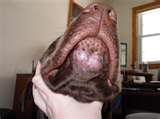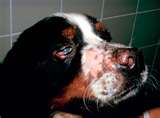Acne in Dogs
Generally occurs in the hair or lips but it can affect other areas of their body
Acne in dogs is similar to acne in humans; however it is centered in their hair more so than in their skin.
The disease itself is referred to as a localized folliculitis, which is an inflammation of hair follicles as well as ruptures that occur.
These ruptures are generally located in your dog’s chin or their lips.
 Chin acne in dogs
Chin acne in dogsAs a result of acne in dogs, comedones, also known as black head, are the first lesion that will appear on their chin.
This is the result excessive keratin formations that in turn cause follicular dilation as well as plugging.
If the acne in your dog is severe enough, it can also cause two other conditions to develop; erythema as well as alopecia.
Erythema is a redness of the skin that is caused by the dilatation as well as the congestion of your dog’s capillaries, and is usually the result of an infection.
Alopecia is the loss of hair in your dog.
In moderate to severe cases of acne in dogs, papules, pustules, as well as firm nodules may also develop primarily from bacterial infections that occur as a result of the acne.
If this does occur, it is now considered to a quite serious.
Acne in dogs will start as your pet reached puberty, which is generally between the ages of five months to nine months old, and is much more prevalent in certain breeds.
POTENTIAL CAUSES
The vast majority of acne cases are in short haired breeds that include Bulldogs, Great Danes, and Dobermans.
It also affects German short-haired pointers as well as Rottweiler’s.
The actual cause of acne in dogs is still not fully understood, but there are some very strong theories.
The first is that it is an allergic reaction to any type of plastic, especially plastic eating or drinking devices, but this is just the beginning of the list.
It is also held that the androgen hormones, which are male sex hormones, are the actual cause of the acne.
However, this argument is challenged by several in the medical community for two reasons.
The first is this condition is by no means sex specific, as it affects both sexes equally.
The second is that this does not explain why it seems to affect primarily short haired breeds.
 Nose acne in dogs
Nose acne in dogsThe next theory is that is genetically caused, which would explain why it affects just short haired breeds.
Some type of traumatic event is also one of the theories as this is believed to release large amounts of free keratin in your dog’s system, which results in an inflammatory response by their immune system.
If this does occur, any bacterium that is in your dog’s hair follicles becomes infected.
The final theory suggests that it is the result of a bacterial infection of some kind.
SYMPTOMS TO WATCH FOR
Acne in dogs will generally first surface as red bumps or papules, as well as comedones or blackheads that will slowly begin to develop on the chin area or lips.
In some cases, these bumps will become infected very quickly, which will produce pus.
If there is infection associated with the acne, the next symptom to occur will be itching. Your dogs will try to relieve this itching by rubbing against furniture or your carpet.
Other symptoms may be red and crusted papules, as well as furuncles that also develop on their chin and lips.
If acne in dogs becomes chronic, you may also start to see signs of a slight depigmentation around the affected areas, which is referred to as secondary depigmentation.
RULING OUT OTHER LIKE DISEASES
Acne does have some very strong similarities with some other condition or diseases, and in order to properly treat the acne, these conditions will have to first be ruled out.
The first of these is called Demodicosis, which is a non-contagious form of mange.
The next disease that will have to be ruled out is ringworm disease, as it will also start with lesions that are very similar to the acne lesions, and this test will take a few weeks.
Your veterinarian will have to test for fungus, and as such, they will have to pluck out some hair and then do a fungal culture test, which takes about two weeks.
The final disease that will need to be ruled out is puppy strangles, as these also start with similar lesions.
However, there will be a couple of major differences; depression and anorexia.
Puppy strangles causes a very sudden depression in a young dog as well as a complete loss of appetite. This condition has neither of these reactions.
TREATMENTS FOR ACNE IN DOGS
Acne has several very effective treatments including medical as well as home remedies.
The medical treatments generally start with topical treatments, and this will include topical washes as well as gels.
Both will contain 2.5 percent benzyl peroxide that needs to be used at least five to six times per week.
However, it is extremely important that you do not use any type of acne treatment for humans, as they could severely damage your dog’s skin.
Human acne treatments contain 10 percent benzyl peroxide which is four times the recommend dosage for your dog. Only use a treatment that is approved for dogs.
In moderate to severe cases, topical antibiotics may be given to help control any type of a secondary infection.
They can be rubbed on your dogs affected areas twice a day which will control any secondary infections as well as bring a lot of relief to your dog.
If it is considered severe and chronic, your veterinarian will provide treatment in the form a pills that are generally given twice a day for several weeks.
Home remedies can also be very effective if the acne is not severe. This will include cleaning the affected areas with warm water and soap applied by a clean washcloth.
This will help to remove any bacteria as well as helping to unplug your dog’s oil glands.
Echinacea, in tablet or liquid form, can also be used as this will act as a mild antibiotic for your dog.
Tincture of calendula, which is from marigold plants, can also be dabbed onto the affected areas by a saturated cotton ball, which will help the lesions from acne in dogs heal much quicker.
Aloe Vera gel is also very effective as a pain reliever, and will help soothe the itching sensation affecting your dog.
Summary
Acne in dogs can last past this formative stage, but it generally resolves itself once your dog reaches their first year of age.
If the acne is not severe and you do choose to use home remedies, you should always consult with your veterinarian on the proper amounts as it will depend on your dog’s size and weight.
Although this is not a serious condition, it can be quite painful in some cases, if it is not treated.
Sources of Treatments for Acne in Dogs








